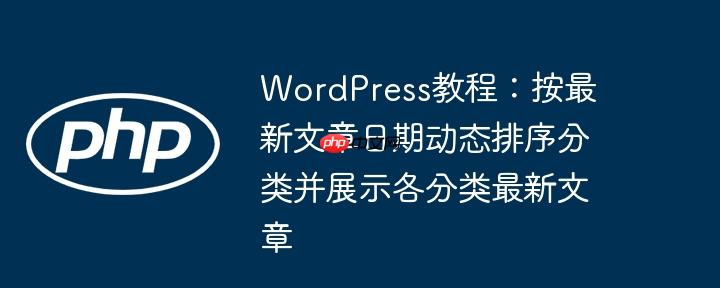
在wordpress网站开发中,一个常见的需求是展示各个分类的最新文章。更进一步地,用户可能希望分类列表本身是动态排序的,即根据每个分类下最新文章的发布日期来决定分类的显示顺序——最新发布文章的分类应排在最前面。这不仅能突出网站的活跃内容,也能引导用户快速发现最新更新的分类。
在不了解WordPress高级查询机制的情况下,开发者可能会尝试以下方法:
原始代码示例可能如下:
<?php
// 获取所有分类,默认按ID或名称排序
$cat_args = array(
'orderby' => 'id' // 或 'name'
);
$categories = get_categories($cat_args);
foreach ($categories as $category) {
// 为每个分类获取最新文章
$post_args = array(
'numberposts' => 1,
'category' => $category->term_id,
'orderby' => 'date',
'order' => 'DESC'
);
$posts = get_posts($post_args);
if (!empty($posts)) {
foreach ($posts as $post) {
setup_postdata($post);
// 这里是展示文章内容的HTML结构
?>
<article <?php post_class('post-list animated fadeIn'); ?> role="article">
<a href="<?php the_permalink() ?>" rel="bookmark" title="<?php the_title_attribute(); ?>">
<figure class="eyecatch<?php if (!has_post_thumbnail()) : ?> noimg<?php endif; ?>">
<?php the_post_thumbnail('home-thum'); ?>
<?php // archivecatname(); ?>
</figure>
<section class="entry-content cf">
<h1 class="h2 entry-title"><?php the_title(); ?></h1>
<div class="byline entry-meta vcard">
<?php if (get_option('post_options_authordisplay', 'author_off') == 'author_on') : ?><span class="writer name author"><?php echo get_avatar(get_the_author_meta('ID'), 30); ?><span class="fn"><?php the_author(); ?></span></span><?php endif; ?>
</div>
<div class="description"><?php the_excerpt(); ?></div>
</section>
</a>
</article>
<?php
// get_template_part('loop'); // 通常不需要在单个文章循环内再次调用
}
wp_reset_postdata(); // 重置全局 $post 变量
}
}
?>这种方法的主要问题在于 get_categories() 无法直接根据分类下最新文章的日期进行排序。它只能按ID、名称、slug等分类自身的属性排序。因此,即使每个分类内部的文章是按最新日期排序的,分类列表的顺序依然是固定的,无法实现我们期望的动态排序。
要解决这个问题,我们需要一个更精妙的策略:首先确定每个分类的最新文章日期,然后根据这些日期对分类进行排序,最后再遍历排序后的分类并显示其最新文章。
我们首先需要获取所有分类,并为每个分类找到其最新文章的发布日期。这将帮助我们构建一个包含排序所需信息的数组。
<?php
$all_categories = get_categories(array(
'hide_empty' => true, // 只获取有文章的分类
));
$categories_with_latest_post_date = array();
foreach ($all_categories as $category) {
// 查询该分类的最新一篇文章,仅获取其发布日期
$latest_post_in_category = get_posts(array(
'category' => $category->term_id,
'posts_per_page' => 1,
'orderby' => 'date',
'order' => 'DESC',
'fields' => 'ids', // 只获取文章ID,减少内存开销
'post_status' => 'publish',
));
if (!empty($latest_post_in_category)) {
$post_id = $latest_post_in_category[0];
$post_date = get_the_date('Y-m-d H:i:s', $post_id); // 获取最新文章的发布日期
$categories_with_latest_post_date[] = array(
'category_object' => $category,
'latest_post_date' => $post_date,
'latest_post_id' => $post_id // 可选,如果后面需要直接引用该文章
);
}
}
?>在获取了每个分类的最新文章日期后,我们可以使用 PHP 的 usort 函数对 categories_with_latest_post_date 数组进行排序。
<?php
// ... (接续步骤一的代码)
// 根据 'latest_post_date' 降序排序
usort($categories_with_latest_post_date, function($a, $b) {
return strtotime($b['latest_post_date']) - strtotime($a['latest_post_date']);
});
?>现在,categories_with_latest_post_date 数组已经按照分类的最新文章日期进行了降序排列。我们可以遍历这个数组,并为每个分类执行 WP_Query 来显示其最新文章。
<?php
// ... (接续步骤二的代码)
if (!empty($categories_with_latest_post_date)) {
foreach ($categories_with_latest_post_date as $category_data) {
$category = $category_data['category_object'];
// 为当前分类运行 WP_Query 获取最新文章
$args = array(
'cat' => $category->term_id,
'post_type' => 'post',
'posts_per_page' => 1,
'orderby' => 'date',
'order' => 'DESC',
'post_status' => 'publish',
);
$query = new WP_Query($args);
if ($query->have_posts()) { ?>
<section class="<?php echo esc_attr($category->slug); ?> listing category-<?php echo esc_attr($category->term_id); ?>">
<h2>最新文章:<a href="<?php echo esc_url(get_category_link($category->term_id)); ?>"><?php echo esc_html($category->name); ?></a></h2>
<?php while ($query->have_posts()) {
$query->the_post();
?>
<article id="post-<?php the_ID(); ?>" <?php post_class('category-listing'); ?>>
<?php if (has_post_thumbnail()) { ?>
<a href="<?php the_permalink(); ?>">
<?php the_post_thumbnail('thumbnail'); // 可以根据需要更改图片尺寸 ?>
</a>
<?php } ?>
<h3 class="entry-title">
<a href="<?php the_permalink(); ?>">
<?php the_title(); ?>
</a>
</h3>
<div class="entry-meta">
<time datetime="<?php echo get_the_date('c'); ?>"><?php echo get_the_date(); ?></time>
<?php if (get_option('post_options_authordisplay', 'author_off') == 'author_on') : ?>
<span class="byline">by <span class="author vcard"><?php the_author_posts_link(); ?></span></span>
<?php endif; ?>
</div>
<div class="entry-excerpt">
<?php the_excerpt(); ?>
</div>
</article>
<?php } // end while ?>
</section>
<?php } // end if
// 恢复原始的全局查询,非常重要!
wp_reset_postdata();
}
} else {
echo '<p>暂无分类或文章。</p>';
}
?>将上述三个步骤整合起来,形成一个完整的解决方案:
<?php
/**
* WordPress教程:按最新文章日期动态排序分类并展示各分类最新文章
*
* 该脚本将获取所有非空分类,根据每个分类下最新文章的发布日期进行排序,
* 然后依次展示每个排序后的分类及其最新的一篇文章。
*/
// 1. 获取所有分类并收集其最新文章的发布日期
$all_categories = get_categories(array(
'hide_empty' => true, // 只获取有文章的分类
'taxonomy' => 'category', // 明确指定分类法
));
$categories_with_latest_post_date = array();
foreach ($all_categories as $category) {
// 查询该分类的最新一篇文章,仅获取其发布日期
$latest_post_in_category = get_posts(array(
'category' => $category->term_id,
'posts_per_page' => 1,
'orderby' => 'date',
'order' => 'DESC',
'fields' => 'ids', // 只获取文章ID,减少内存开销
'post_status' => 'publish', // 确保只获取已发布的文章
'suppress_filters' => true, // 避免插件过滤器影响此特定查询
));
if (!empty($latest_post_in_category)) {
$post_id = $latest_post_in_category[0];
// 获取最新文章的发布日期,用于后续排序
$post_date = get_the_date('Y-m-d H:i:s', $post_id);
$categories_with_latest_post_date[] = array(
'category_object' => $category,
'latest_post_date' => $post_date,
'latest_post_id' => $post_id // 可选,如果需要直接引用该文章ID
);
}
}
// 2. 根据 'latest_post_date' 降序排序分类数组
if (!empty($categories_with_latest_post_date)) {
usort($categories_with_latest_post_date, function($a, $b) {
// 比较两个分类的最新文章日期,实现降序排序(最新在前)
return strtotime($b['latest_post_date']) - strtotime($a['latest_post_date']);
});
// 3. 遍历排序后的分类并展示其最新文章
foreach ($categories_with_latest_post_date as $category_data) {
$category = $category_data['category_object'];
// 为当前分类运行 WP_Query 获取最新文章
$args = array(
'cat' => $category->term_id,
'post_type' => 'post',
'posts_per_page' => 1,
'orderby' => 'date',
'order' => 'DESC',
'post_status' => 'publish',
'suppress_filters' => true, // 避免插件过滤器影响此特定查询
);
$query = new WP_Query($args);
if ($query->have_posts()) { ?>
<section class="<?php echo esc_attr($category->slug); ?>-listing category-section">
<h2 class="category-title">
<a href="<?php echo esc_url(get_category_link($category->term_id)); ?>">
<?php echo esc_html($category->name); ?> (最新)
</a>
</h2>
<?php while ($query->have_posts()) {
$query->the_post();
?>
<article id="post-<?php the_ID(); ?>" <?php post_class('latest-category-post'); ?>>
<?php if (has_post_thumbnail()) { ?>
<div class="post-thumbnail">
<a href="<?php the_permalink(); ?>">
<?php the_post_thumbnail('medium'); // 推荐使用注册的图片尺寸 ?>
</a>
</div>
<?php } ?>
<h3 class="entry-title">
<a href="<?php the_permalink(); ?>">
<?php the_title(); ?>
</a>
</h3>
<div class="entry-meta">
<span class="posted-on">发布于 <time datetime="<?php echo get_the_date('c'); ?>"><?php echo get_the_date(); ?></time></span>
<?php if (get_option('post_options_authordisplay', 'author_off') == 'author_on') : ?>
<span class="byline">by <span class="author vcard"><?php the_author_posts_link(); ?></span></span>
<?php endif; ?>
</div>
<div class="entry-excerpt">
<?php the_excerpt(); ?>
</div>
</article>
<?php } // end while ?>
</section>
<?php } // end if
// 恢复原始的全局查询,非常重要!
wp_reset_postdata();
}
} else {
echo '<p>暂无符合条件的分类或文章可供展示。</p>';
}
?>wp_reset_postdata() 的必要性: 在每次 WP_Query 循环结束后,务必调用 wp_reset_postdata()。这会将全局的 $post 对象和相关数据恢复到主查询之前的状态,避免对后续的WordPress循环或函数产生意外影响。
性能考虑: 在 foreach 循环中多次调用 get_posts() 和 new WP_Query() 可能会对性能产生一定影响,尤其是在分类数量非常多或文章数量庞大的网站上。
无文章分类的处理: 在步骤一中,我们使用了 'hide_empty' => true 来确保只处理有文章的分类。如果需要展示空分类,可以移除此参数,并调整逻辑以处理 latest_post_in_category 为空的情况(例如,将这些分类排在列表末尾或不显示)。
自定义文章类型支持: 如果你的网站使用了自定义文章类型(Custom Post Types),并且希望它们也能参与排序和展示,你需要调整 get_posts 和 WP_Query 中的 post_type 参数,将其设置为相应的自定义文章类型或一个数组来包含多种类型。
代码位置: 这段代码通常放置在主题的模板文件(如 home.php, archive.php, page.php 或通过 do_action / add_action 钩子)中,具体取决于你希望它在网站的哪个位置显示。
错误处理与用户反馈: 在代码末尾添加了 else 分支,用于在没有符合条件的分类或文章时给出友好的提示。
通过上述分步实现和代码示例,我们成功解决了在WordPress中按最新文章日期动态排序分类并展示各分类最新文章的需求。这个解决方案兼顾了功能实现和一定的性能考虑,通过清晰的逻辑和适当的WordPress API调用,为网站内容展示提供了更大的灵活性和更好的用户体验。记住,在实际部署时,根据你的网站规模和具体需求,可以进一步考虑性能优化和缓存策略。
以上就是WordPress教程:按最新文章日期动态排序分类并展示各分类最新文章的详细内容,更多请关注php中文网其它相关文章!

每个人都需要一台速度更快、更稳定的 PC。随着时间的推移,垃圾文件、旧注册表数据和不必要的后台进程会占用资源并降低性能。幸运的是,许多工具可以让 Windows 保持平稳运行。

Copyright 2014-2025 https://www.php.cn/ All Rights Reserved | php.cn | 湘ICP备2023035733号